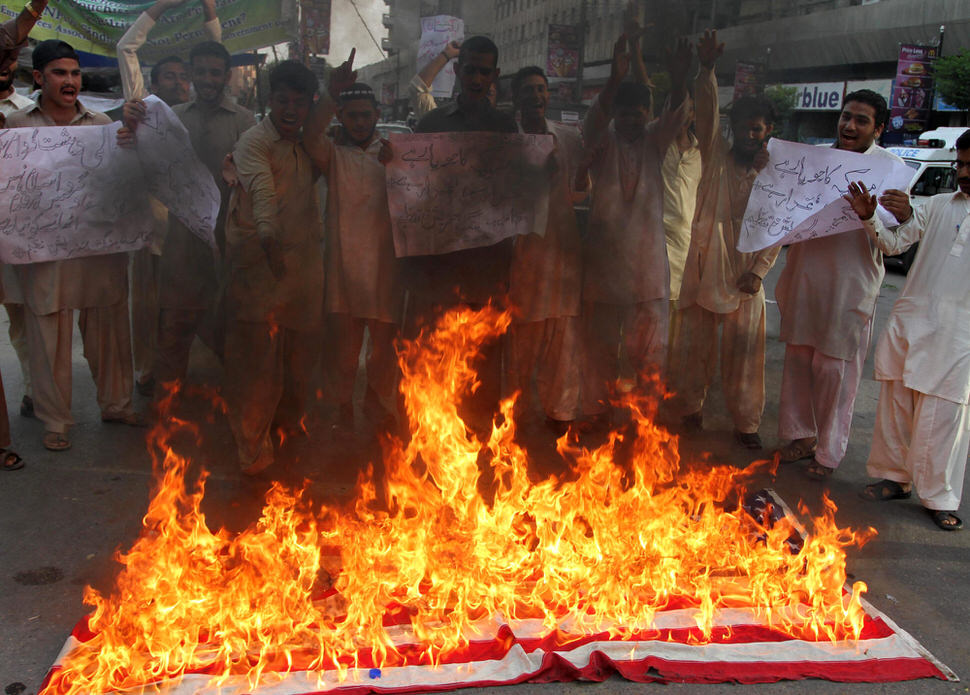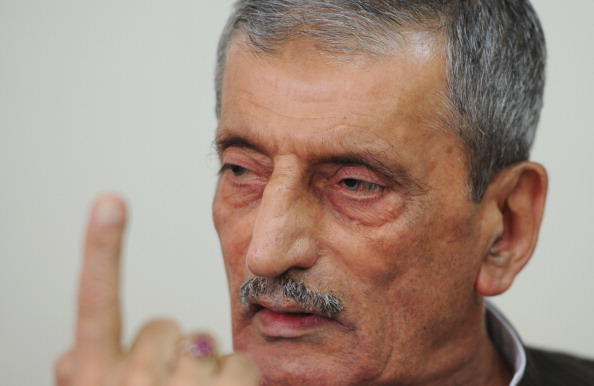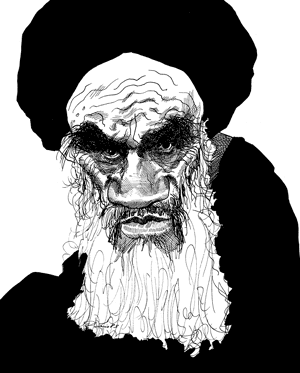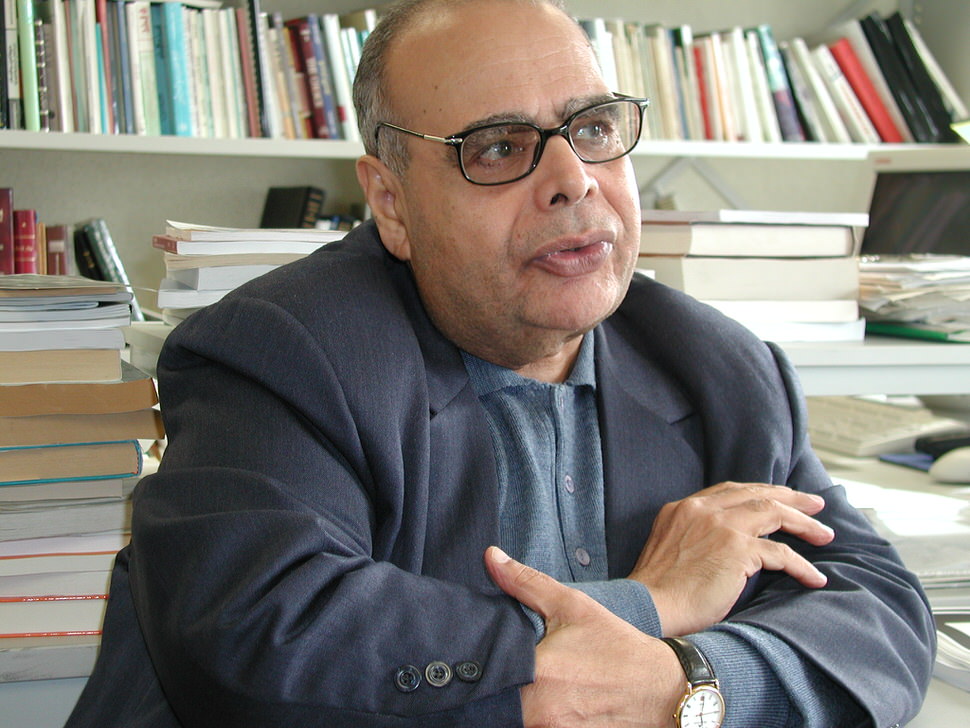It may be ironic, but it is not entirely surprising that the YouTube clip of what appears to be a badly made film satirizing the Prophet Muhammad appeared, causing mayhem and destruction—coinciding with the death of US ambassador to Libya Christopher Stevens—in the same week of September that the novelist Salman Rushdie published Joseph Anton. The memoir recounts Rushdie’s life as a “celebrity victim” after Iran’s Supreme Leader, Ayatollah Khomeini, issued a fatwa calling for his death for offending Islam in his novel The Satanic Verses. Not to be outgunned by the late Ayatollah, the Pakistani railroad minister Ghulam Ahmad Bilour has now personally offered a $100,000 reward to anyone who murders the maker of Innocence of Muslims, the crude new film.
The Pakistani minister’s intended victim appears to be Nakoula Basseley Nakoula, an Egyptian-American Christian who used the alias Sam Bacile when producing the film, which in the YouTube clip shows a young, long-haired Muhammad indulging in oral sex with a Bedouin woman in her tent. Since Nakoula had received a number of death threats, newspaper pictures and television shots showed him shrouded and under heavy guard as he was bundled into a police vehicle when he was arrested by the Los Angeles police for violating the terms of his probation on bank fraud charges dating from 2010. The parallels with Rushdie’s disappearance from public view after Khomeini issued his notorious fatwa on St. Valentine’s Day, 1989, were somewhat uncanny.
Invited to sympathize with Nakoula’s predicament, Rushdie made a crucial distinction. “I think he’s done something malicious, and that’s a very different thing from writing a serious novel,” he said on CNN’s Today show. “He’s clearly set out to provoke, and he’s obviously unleashed a much bigger reaction than he hoped for…. He set out to create a response, and he got it in spades.”
However, the responses to both Rushdie’s book and Nakoula’s film are evidently motivated in part by the same issue: the belief, now dominant among Islamists and even some non-political Muslims, that (contrary to numerous precedents in Islamic art history) the image of the Prophet must always be aniconic, and that representations of him—let alone inflammatory caricatures—are absolutely forbidden. Many will recall the violent reaction to the Muhammed cartoons originally published in a Danish newspaper—cartoons that continued to provoke extremist attacks years after their publication. Indeed, even as the debate over the new anti-Muslim film was playing out in September, a French weekly, Charlie Hebdo, incited further tensions in the Muslim world by publishing a new set of cartoons, one of them showing the Prophet’s naked backside.
On the motives behind the film Rushdie is surely right: researchers have revealed close connections between Nakoula, a militant Coptic separatist, and out-and-out Islamophobes such as Pamela Geller and Robert Spencer. (Indeed, even as people in the Middle East were rioting against the film in late September, Geller was sponsoring a controversial anti-Muslim advertising campaign in the New York subway, raising questions about hate speech in the United States.) The film’s consultant, Steve Klein—an insurance salesman from Hemet, California—has been linked to the extreme “counter-jihadist” or “anti-Muslim crusader” current that inspired or even had connections with the right-wing extremist Anders Brevik, now serving a life sentence for the July 2011 Utoya massacres in Norway.
Matthew Feldman, a political scientist, has used the term “Christianism” to describe ultra-right-wing anti-Muslim polemicists such as Geller and the Quran-burning pastor Terry Jones, who also supported the film, in order to highlight their similarities to their Islamist enemies. Both rely on religious feelings to mobilize much larger groups because of the esteem for their respective religions in the broader cultures in which they reside.
There is some comfort in the thought that both kinds of extremists—Christianist and Islamist—are relatively small in number. In Egypt the security services of the pro-Islamist Muslim Brotherhood government rounded up the mostly youthful rioters who stormed the US Embassy in Cairo in a fracas that caused just one fatality. In Libya the killers of Ambassador Stevens, militants belonging to a group known as Ansar al-Sharia (“helpers of the holy law”), were well-armed but few, and have subsequently been expelled from Benghazi—and in some cases killed—in a populist backlash. (Ansar al-Sharia may have been acting independently of the anti-video protesters.) And despite being government-sanctioned, the protests in Pakistan, dubbed the “Day of Love for the Prophet Muhammad,” drew estimated crowds of at most five-thousand to ten-thousand people—“fewer than would typically attend a mainstream political rally, or even a high-profile funeral,” according to Declan Walsh of The New York Times. (They did however result in the deaths of up to 19 people.)
Advertisement
However, in a world where millions of people have instant access to the kinds of images shown on YouTube, it is becoming increasingly difficult to maintain Rushdie’s distinction between a “serious novel” (to be enjoyed, as it were, in the private space of a reader’s imagination) and what the novelist himself describes as a “deliberately malicious video.” The Satanic Verses, quite apart from its title, was itself intentionally provocative: its labored lampooning of Muhammad’s sexuality, after all, addressed some of the same issues, if less crudely, as the outrage-provoking trailer shown on YouTube. Rushdie’s title refers to an episode in the life of the Prophet that is recorded by some of his chroniclers. In it, Satan is said to have interpolated some verses into the Quran, a book that believing Muslims regard as the unmediated word of God. These “Satanic” verses—which extolled three female deities worshipped by the pagans of Mecca—were subsequently removed, but the episode could be used to cast doubt on the divine provenance of the Quran (although some early commentators had no problem with the story).
This disputed part of the Prophet’s life, however, is only a small part of an extremely complex novel that explores the psychological impact of migration and the conflicting cultural forces to which migrants find themselves exposed. The novel parodies the ingredients of Indo-British Muslim identity. Mixing fact with fiction, history with myth, it ridicules some of the brittle shibboleths surrounding Muslim beliefs and identities: not just the integrity of the Quran, but, much more dangerously, the sexuality of Mohammed and the honor of his wives. In the dreams of Gibreel, who is one of the novel’s protagonists, Islam’s most central rite, the Hadj or pilgrimage to Mecca, and the prophet Mohammed are subject to merciless satire.
In a series of scenes reminiscent of Jean Genet’s famous play Le Balcon—in which a brothel’s patrons assume the roles of bishop, judge, and general—Rushdie has prostitutes at The Curtain (the primary meaning of hijab, or veil) play the part of the prophet’s wives, the most popular being the fifteen-year-old Ayesha (the name of Mohammed’s youngest wife). Clients circulate around a Fountain of Love “much as the pilgrims rotated for other reasons around the ancient Black Stone” in Mecca. This anti-mosque evidently mocks attitudes to women legitimized by Mohammed’s numerous marriages. The poet Baal presides in the brothel as a kind of anti-prophet. Whether or not Baal symbolizes his creator, his role in the novel is prescient:
A poet’s work is to name the unnameable, to point at frauds, to take sides, start arguments, shape the world and stop it from going to sleep. And if rivers of blood flow from the cuts his verse inflict, then they will nourish him.
At least sixty people are believed to have been killed in the agitation that followed the publication of The Satanic Verses in 1988–1989 in India and Pakistan, two in Belgium, and thirty-seven in Sivas, Turkey, in an arson attack by Islamists on a hotel where the book’s Turkish translator, the novelist Aziz Nesin, and other writers were meeting. In an incisive review of Rushdie’s new memoir in The Guardian, Pankaj Mishra suggests that the attitudes revealed in The Satanic Verses belong to an earlier, less complex age than the one we live in today. Rushdie’s
neat oppositions between the secular and the religious, the light and the dark, and rational literary elites and irrational masses do not clarify the great disorder of the contemporary world. They belong to an intellectually simpler time, when non-western societies, politically insignificant and little-known, could be judged solely by their success or failure in following the great example of the secular-humanist west; and writing literary fiction could seem enough to make one feel, as Tim Parks wrote in a review of Rushdie’s novel The Ground Beneath Her Feet, “engaged on the right side of some global moral and political battle.”
Mishra finds it somewhat ironic that that in his “brilliant early phase” the author of Midnight’s Children and Shame had bravely attacked “such complacencies of imperial intellectual cultures.” He is evidently disappointed by what he sees as Rushdie’s failure, in Joseph Anton, to “abandon the conceit, useful in fiction, but misleading outside it, that the personal is the geopolitical.”
The heart of the matter, as I found in my own exploration of the Rushdie affair back in 1989, is that lampooning the prophet—especially in conjunction with sexual issues—raises questions of Muslim identity that go beyond religious belief.
Advertisement
Building on the neuroscientist Susan Greenfield’s notion of group identity, one could suggest that—after many centuries of “programming” by means of ritual, devotion, and prayer—the cultural myth of the Prophet, like that of other religious icons, is so integral to the construction of how many Muslims see themselves that an assault on the Prophet may be experienced as an attack on all Muslims.
Indeed, its worth considering that what secular people are inclined to regard as religious fanaticism or intolerance is often less about differences of belief than about manifestations of customs or social attitudes that are the outcome of those beliefs. Theological differences—about God, the Virgin, the Real Presence, the divine mission of Muhammad, the docetic Christology of the Quran (according to which Jesus was not crucified), the inheritance of Ali ibn abi Talib, or the martyrdom of the Imam Hussein—are not the real reasons that people indulge in murderous behavior toward their neighbors or “intimate enemies.”
Religious conflicts, between Catholics and Protestants, Sunnis and Shias, Hindus and Muslims, are often best understood as “turf wars” over the less tangible, but not in itself theological, issue of human “respect.” Threats were made against Rushdie and Kurt Westergaarde, the Danish cartoonist who depicted Muhammad with a bomb-shaped turban, not because they may or may not be “non-believers,” but because they were deemed to have insulted Muslims by violating the aniconic image of the Prophet Muhammad.
Militants such as the killers of the US ambassador to Libya, Salafists in Cairo, Hezbollah activists in Lebanon, and Taliban supporters in Kabul have all used the YouTube film to mobilize support against governments perceived as pro-Western, or pro-American. But the fact remains that there is populist mileage in defending the image of Muhammad—an image that has been given the status of something that cannot be reproduced or denigrated for more than fourteen centuries—and this can extend to more serious-minded critical discussion of Islam as well. In 1995, for example, the Egyptian scholar Nasr Abu Zayd was effectively forced into exile after being declared an “apostate,” a ruling that led to the annulment of his marriage under Islamic law. Abu Zayd had infuriated fundamentalists by applying modern critical methods to the text of the Quran. The affair sets a legal precedent that bodes ill for the future of scholarship under Egypt’s current Muslim Brotherhood-dominated regime.
There may be a crucial difference between being seen to trash the image of Muhammad publicly, as in the case of the Danish cartoons and the YouTube clip, and the deconstruction of that image using the tools of modern scholarship. Historian Tom Holland’s recent documentary Islam the Untold Story, based on his book In the Shadow of the Sword: The Birth of Islam and the Rise of the Global Arab Empire, which questions the historicity of the Arabian prophet, drew protests from some Islamic scholars, and Britain’s Channel Four TV network cancelled a screening and public discussion after Holland received a torrent of abusive messages on Twitter. Nevertheless the program went out as scheduled, and it was accessible online. Above all it did not generate riots from Benghazi to Kabul.
These contrasting responses suggest the possibility of a two-pronged approach to the free speech issues raised by images of the Prophet. “Insulting” the Prophet with the intent of stirring up hatred might be categorized as a form of “hate speech” comparable to anti-Semitism, racism, flag desecration, or Holocaust denial, which are forbidden by law in many countries (though not the US, where a proposed amendment protecting the US flag failed to pass by a single Senate vote in 2006), because the sacred image of the Prophet has become a fundamental part of how Muslim communities have come to define themselves. While in practice it may be difficult to draw the line between “insult” and “criticism,” if there is a distinction it must lie in intention.
In Britain, for example, the government’s effort in the wake of the Rushdie Affair to extend the race relations act in response to Muslims protests opened a legal minefield. It is now an offense (under the 2006 Racial and Religious Hatred Act) to display by writing or other visible representation material that is “threatening, abusive or insulting” with the intention of causing “harassment, alarm or distress.” Yet the law paradoxically protects the right to “insult and abuse” with a proviso stating that nothing in it “shall be read or given effect in a way which prohibits or restricts discussion, criticism or expressions of antipathy, dislike, ridicule, insult or abuse of particular religions or the beliefs or practices of their adherents.” Intention is clearly the key. Had he been required to defend his book under the 2006 act, Rushdie and his lawyers would doubtless have argued that the storm of controversy it raised was an unintended consequence of a misreading (mostly by politically-motivated parties) of his “serious” novel.
Critical analysis of the Quran that challenges the myths surrounding the primal figures of Islam is another story entirely: it is something that scholars of other faiths have been engaged in since the Enlightenment. Since the nineteenth century, Islamic scholars such as Sayyed Ahmad Khan and Chirag Ali have questioned the authenticity of many of the hadiths (verbally transmitted reports) on which the earliest chroniclers relied for their accounts of the Prophet’s life, exemplary behavior, and ministry. It would be utterly wrong for the law to discriminate in favor of (or effectively against) Muslims by insulating them from this process, because critical engagement—about science, religion, and politics—is a necessary precondition for communities to flourish in a cosmopolitan and increasingly globalized world.





